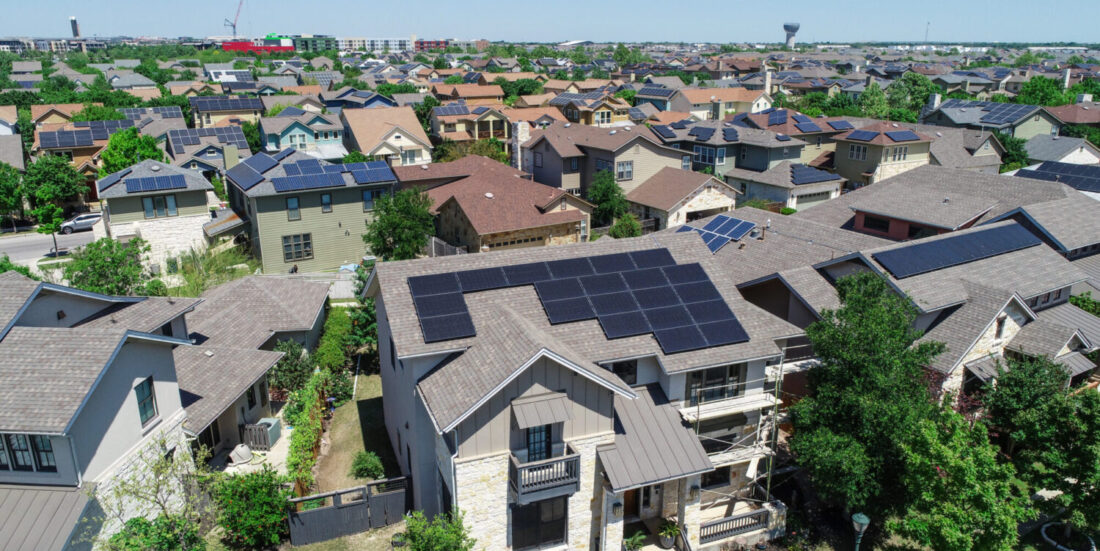What will the price of your neighbours solar power be?
In the future, we will see the emergence of local energy communities made up of households and businesses who buy and sell electricity among themselves. But someone will have to work out how to determine the price.
The Norwegian government’s new sharing scheme for self-generated, renewable energy, which came into force on 1 October, represents one of many steps on the road to local electricity sharing. The scheme enables electricity customers in housing cooperatives, multi-person dwellings and business premises to share the electricity they generate from installations such as solar panels. It will also enable them to avoid paying grid tariffs and other charges for their electricity consumption.
Researchers at SINTEF and NTNU have recently been studying which price models will work best when this solar electricity is released onto the market.
According to the researchers, it is only a matter of time before such local energy communities will be established here in Norway.
Local electricity sharing
Local energy communities are independent legal entities that generate, distribute and consume their own electricity. Some members of these communities may generate a lot of energy, some less, while others may only be consumers.
“Within such communities, the price of electricity generated locally must be determined in the right way”, says Sigurd Bjarghov, who is a research scientist at SINTEF Energy Research. “As well as those who generate and consume the electricity, the community will have to involve the grid companies, innovative electricity companies and the public authorities”, he says.
Since the price of electricity is to a large extent determined by the choice of price mechanism, many issues have to be considered when making this selection. For example, how will the benefits of local trading be distributed between those who generate the electricity and those who consume it? And will those who generate the electricity, having invested in renewable energy infrastructure, enjoy the majority of the savings themselves, or will the consumers also get a substantial slice of the cake?
If we accept that the establishment of local energy communities in Norway is inevitable, issues such as these will be crucial to those charged with running them. Moreover, the public authorities should already be thinking carefully about the long-term incentives they will issue under the government’s sharing scheme, so that all those involved can plan ahead with some level of certainty.
“If the authorities stick to the principle that local electricity sharing will be exempt from charges and grid tariffs, we must accept that sellers will get a higher price by selling locally than they would by offering their electricity to the grid company”, says Bjarghov. “By the same token, purchasers will pay less. This principle results in lower and upper price limits within a given community to which it can refer during its negotiations”, he says.
Choosing a price model
The way in which electricity prices are determined represents a key design choice for any local energy community. This is because of the direct impact the selected approach will have on the profitability of any investment in solar panels.
“The choice of price setting model and the data that have to be shared are key factors that have to be resolved in order for local electricity trading to take place”, says Marthe Fogstad Dynge, who is a research fellow at the Department of Electrical Energy at NTNU.
As part of a study from earlier this year, Dynge, Bjarghov and their colleagues have been taking a detailed look at three different price models and how these will influence the electricity price within a local energy community.

In a local energy community, some members may generate a lot of energy, some less, while others may only be consumers. Figure courtesy of SINTEF
The team’s research was carried out as part of a case study involving the internal market within a fictional local energy community consisting of ten ‘units’ that generate varying amounts of solar electricity. Some of the units in the community are only purchasers and generate no electricity whatsoever.
“Based on our results, we are recommending that local energy communities start by adopting what we call a ‘supply and demand’ model – for no other reason than that this is an easy place to start. In time, we believe that a model based on an equilibrium-based pricing mechanism will prevail, but to achieve this we will need better management of personal privacy issues”, says Dynge.
Best for the consumers
As its name suggests, the supply and demand model identifies the link between supply and demand and uses this to determine a price lying somewhere between the aforementioned lower and upper limits. Price determination is based on prices prevailing in the domestic market, combined with reductions in charges, taxes and grid tariffs. If a major surplus of solar electricity arises, the price will be at or very close to the lower limit. If demand is high, but levels of solar electricity generation are low, the price will be fixed close to the upper limit.
“This arrangement is uncomplicated and easily comprehensible. It also requires very little data sharing”, says Dynge. “It has the advantage of being transparent and easy to explain to the general public. However, it is the only model among the three we investigated that for the most part benefits consumers ahead of producers”, she says.
A fair price model
According to economic theory, an equilibrium-based model should offer the fairest option. In this model, the price is determined on the assumption that perfect competition operates within the local market. The average local market price lies somewhere between that determined using the two other approaches. This makes the equilibrium-based model an acceptable compromise solution for both buyers and sellers. It is both uncomplicated and transparent because the price is set at either the upper or the lower limit, depending on whether there is more demand or more supply. Many people are familiar with this concept.
“Nevertheless, data security is not as effective using this mechanism because it requires a lot of data to be submitted by all market participants”, says Bjarghov. “It is possible to overcome these challenges, but the model may always be seen as problematic by consumers concerned about personal privacy issues”, he says.
The third and final model is based on the concept of distributed optimisation. It is not recommended by the researchers, even though it does not require the sharing of detailed personal data.
“It is much more complex and thus difficult for most people to understand”, says Dynge. “Nor is it very transparent. It also results in higher prices locally on average than the other two models”, she says.
The researchers are now looking to test the different price mechanisms as part of a pilot project, where the aim will be to verify the approaches they have used.
“A pilot project such as this will also enable us to provide useful input about the participants’ own experiences, as well as how they feel about data sharing issues and the transparency of the various methods”, says Bjarghov.
The results of the study are published in the following article in the journal Applied Energy, published by Elsevier: Local electricity market pricing mechanisms’ impact on welfare distribution, privacy and transparency.



